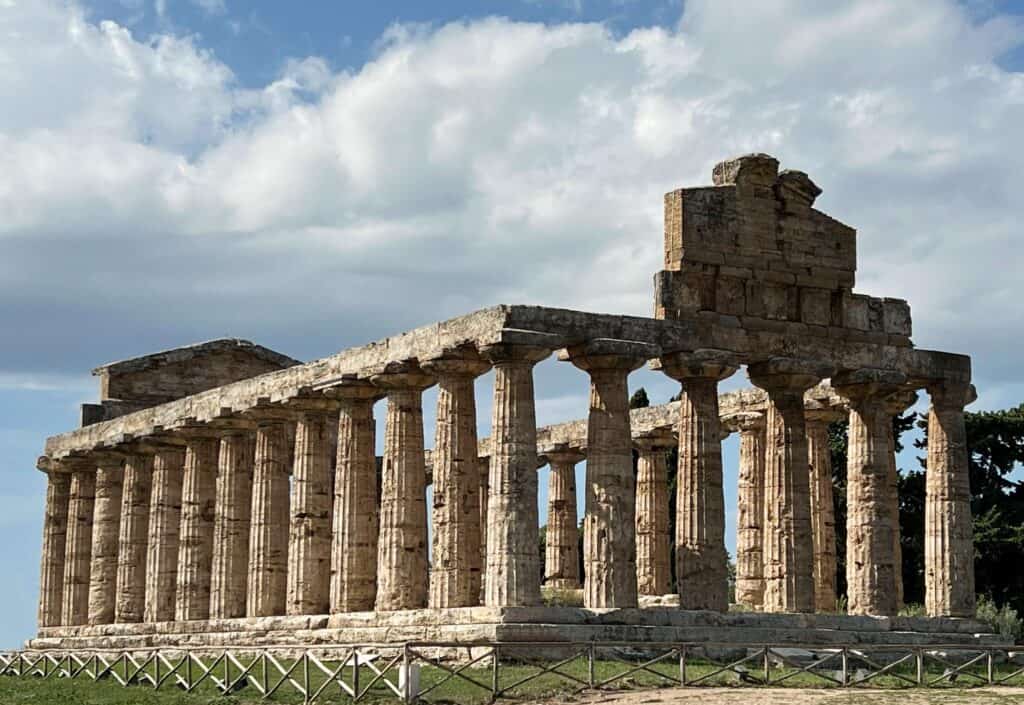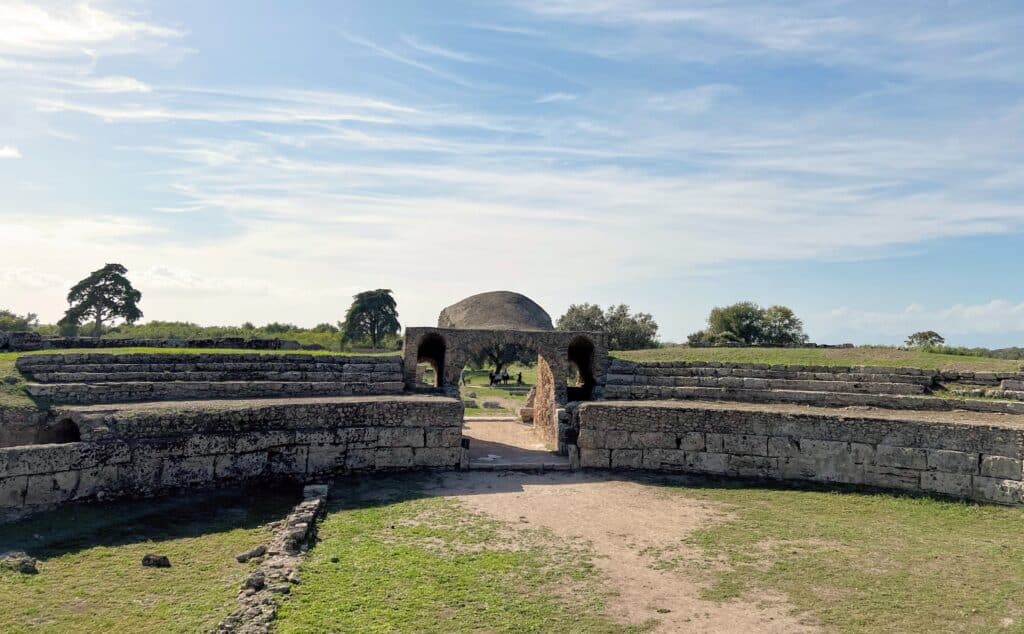Visiting Paestum’s Ancient Greek Temples
Southern Italy has been luring civilizations for thousands of years, only to wipe them out with catastrophe. Volcanic eruptions aside, the shifting coastline south of Naples transformed communities into malarial swamps. Ironically, the destruction actually preserved the fabric of Paestum. This 2,500 year old settlement retains some of the most complete – and spectacular – ancient Greek temples anywhere. We found the UNESCO World Heritage archaeological park every bit as impressive as Pompeii and Herculaneum, and in fact it makes a fascinating complement to those sites. Paestum is also much less crowded and quite easy to get to.
Paestum’s Origins: Poseidonia and Magna Grecia
In the eighth and seventh centuries BCE, Greeks expanded from trading posts to permanent settlements in southern Italy. Over time the communities grew dense enough to earn the nickname Magna Grecia, or Greater Greece. On the Cilento coast south of Naples, a new colony named Poseidonia (after the god of the sea) grew into a small city with roads and its own coinage.

During the sixth and fifth centuries BCE, the inhabitants of Magna Grecia erected temples celebrating their gods and goddesses. Poseidonia’s three temples showcased newly-formulated principles of proportion and harmony and likely served as a major inspiration for the Parthenon in Athens.
Paestum’s Temples
Like all Greek temples, the ones in Paestum held a ceremonial statue of a god or goddess in the center, enclosed by walls and a roof. Scholars used to think that only priests had access to the inner sanctum, but it’s now believed that it would have been open to some members of the population. One set of columns surrounded the central shrine, and a second set ran around the perimeter of the structure.
The oldest of Paestum’s temples, dating to roughly 550 BCE, lies on the southern end of the site. Dedicated to Hera, it features a typical altar in front of the building itself, used for sacrifices and worship by the general community. Even at this relatively early date, Greeks had already begun to manipulate visual perception. For instance, the pronounced widening of the columns at the base makes them appear taller. The Temple of Hera has nine columns across its shorter side, which is highly unusual: Greek structures generally used an even number of columns to create a symmetrical view of the sanctuary inside.

Because of Paestum’s distance from sources of marble or hard stone, the temples were built from travertine, a local type of limestone. This may explain the relatively low amount of carved stone reliefs adorning the structures and the use of painted terracotta for details. Some of the columns’ capitals still retain traces of paint, but the fragments in the museum show the colors better – mostly red, white, and deep blue.

Just north of the Temple of Hera, a second structure was built about a hundred years later. Originally presumed to have honored Poseidon, it’s now thought to have venerated two gods, possibly Zeus and Hera. Sometimes it’s called the Temple of Poseidon (or the Roman equivalent Neptune) and sometimes the Second Temple of Hera.

The Temple of Poseidon retains the older Doric style, but with a monumental innovation: an imperceptible curve in the length of the building makes it look perfectly straight to the naked eye. The Parthenon in Athens famously adopted the idea.

The Temple of Athena sits further north on the highest point of town. It was built around 500 BCE, and was first thought to have been dedicated to Ceres. Although built before the Temple of Poseidon, its relatively slender proportions represent a transition towards the Ionic style. In later centuries, Christians removed the interior structure so they could use the temple as a church.

Compared to Roman structures, the temples at Paestum can appear a little squat or brawny at first. Without arches and more advanced engineering knowledge, ancient Greeks had to rely on thick supports with short distances between them. Within these confines, however, they made subtle adjustments – tilting a column here, curving a line there – which show an incredibly sophisticated understanding of human vision. The temples’ proportions look simple, but their ability to hold the eye has astounded visitors for thousands of years.
Paestum After the Greeks
Local inhabitants of the southern Italy known as Lucanians descended upon Poseidonia in the fourth century BCE. These horse-racing fanatics largely adopted Greek culture, and created many of the painted tombs on view in the museum. Romans took over in 273 BCE and renamed the community Paestum. Land drainage became increasingly problematic, and the collapse of the Roman empire in the fourth and fifth centuries precipitated Paestum’s decline.
By the Middle Ages, the marshy area was associated with malaria and abandoned for good. Towards the end of the 11th century, Normans raided the ancient town for building materials to use in the Salerno cathedral (see link at the bottom of this post for more information), but otherwise Paestum disappeared from history.
Eventually civilization crept back, and the site was rediscovered during construction of a new road in the 18th century. The unearthing of Pompeii sparked a surge of interest in ancient sites, and soon illustrations of Paestum by artists such as Piranesi began circulating throughout the continent.
Other Structures at Paestum

Visitors can find the famous heroön (memorial) near the Roman forum. Once buried under Roman construction, the low stone chamber was excavated in 1954. In addition to a large ceramic amphora imported from Athens, some bronze vessels were found with traces of honey inside over 2500 years after their burial. All the artifacts are now displayed in the museum.
Many of Paestum’s smaller buildings were looted for construction materials. An elegant round sunken council chamber remains from Greek days, and there is also a semi-submerged Roman amphitheater. Already quite small compared to other sites, it suffered the indignity of having a modern road laid over half of it.
Paestum National Archaeological Museum

Paestum’s archaeological site includes admission to the museum just across the road. Its impressive collection includes architectural fragments and artifacts from Paestum and the surrounding region. The most famous piece is the Tomb of the Diver, the world’s only intact figural Greek scene painted between 700-400 BCE. Other highlights include a series of metopes (carved panels) illustrating the labors of Hercules, exquisite black-figure pottery, and plenty of Lucanian horse paintings.
Paestum’s Survival
In spite of Paestum’s remote location and swampy conditions, not all of the town survived. Why the temples remain when other structures did not is beyond the scope of this post, but it’s worth noting that during the Second World War both sides agreed to avoid bombing the temples.

Practicalities
Paestum’s archaeological site opens at 8:30 and closes shortly before sunset. The museum is open daily from 8:30-7:30, except for the first Monday of each month. For specific hours, check the OpenPaestum website.
Tickets for both the archaeological area and the museum cost €10. It’s also possible to visit them separately.
The Porta Principale ticket office can store bags and luggage. A few cafés and souvenir shops line the road adjacent to the museum.
Paestum’s train station is an easy 10-minute walk from the archaeological site. The train takes about 40 minutes from Salerno or 80 minutes from Naples.
Parking near the site costs about €3.
We recommend staying in Salerno, which provides easy access to Pompeii and Herculaneum, Naples, and the Amalfi Coast as well as Paestum.
Further Reading
For more on ancient Greek settlements in Italy, see our post on Syracuse, Sicily.

